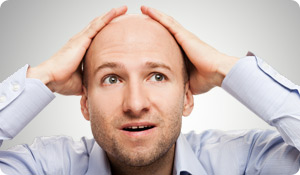
Muffin top middles look awful and signal poor health. Back fat is unsightly too and nobody wants flabby arms that wriggle. The good news is there's one place on the body where having fat actually helps you look better—the head. It turns out hair growth isn't possible without fat.
Assistant professor of Molecular, Cellular, and Developmental Biology and Senior Researcher at Yale University, Valerie Horsley and her team of researchers observed that when hair dies, the layer of fat in the scalp that comprises most of the skin's thickness shrinks. Conversely, when hair growth begins, the fat layer expands. The process is called adipogenesis.
About 40 million men in the U.S. are affected by male pattern baldness-the most common type of hair loss. Although hair loss may be caused by disease, medicine, medical treatments, and stress, male-pattern baldness is related to aging, heredity, and changes in testosterone levels.
Everyone loses hair and some hair loss is normal. According to the American Academy of Dermatology, the average person loses between 50 to 100 hairs every day—not terribly significant considering a typical scalp has 100,000 hairs. A receding hairline, bald patches, or thinning around the temples are generally a sign of male pattern baldness which is medically known as androgenetic alopecia. Surgery and medication that work to provoke hair growth are available to treat this condition, but the Yale researchers believe their findings could put an end to toupees, transplants, minoxidil, and finasteride since they may have uncovered the key to generating new hair growth.
For years, scientists have known that stem cells can be used to grow new hair-producing follicles but haven't learned how to signal them to do so. People with male-pattern baldness don't lack stem cells in their hair follicle roots but instead lack the fat which may make hair follicle roots dormant. Researchers suspected the signal to switch on the hair growth process might be buried in the fat cells.
To test their theory, they injected mice unable to grow hair and fat tissue with a type of stem cell involved in the creation of new fat cells called adipose precursor cells. Before the injection, the follicles of the mice were dormant but two weeks following the injection, the study found that hair follicles had begun to grow. "The fat cells are important for hair growth. If they're not there, the hair won't grow," Horsley said in a press release.
The precursor fat cells also produced a chemical called platelet-derived growth factor that aids in hair growth 100 times faster than normal cells do. Up to 86 percent of hair follicle grown was restored in mice with the injection of this chemical.
"We don't know for sure if it's a cure for baldness," the study author told the Yale News, "But we are hopeful that in humans, adipocyte precursor cells (stem cells) will also be a viable therapy to induce hair growth."
Going forward, researchers will explore whether the cellular signaling in mice works the same way in humans. The study's findings also don't address hair loss involving DHT. (DHT is a product of the male hormone testosterone and is thought to cause hair follicles to shrink, but its role is not completely understood.)
No doubt there's more work to be done in the hair area. In the meantime, embrace your baldness. After all, being bald is fashionable in certain circles and you may as well enjoy the money you save from not needing haircuts or buying shampoo. Here's something else to consider: being called a fat head just might be a compliment in the not-so-distant future.
Sources:
Yale University
http://www.yale.edu
The American Academy of Dermatology
http://www.aad.org
The American Hair Loss Council
http://www.ahlc.org
Family Physicians
http://www.familydoctor.org





